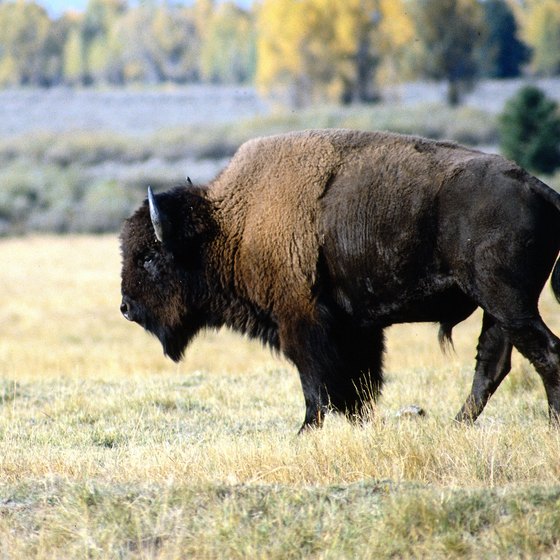What Animals Did People Bring When Traveling West
Thousands of settlers searching for a new life traveled the Oregon Trail from Missouri to Oregon, braving the heat of the plains and the arduous trek over the Rocky Mountains. The earliest went by horse and on human foot, but when the Great Migration occurred in 1843, prairie schooners – covered wagons lighter than Conestogas – made it easier for families to head to the Oregon Country. Many of the settlers and trail guides kept contemporaneous accounts of the familiar and unfamiliar animals they encountered.
A Grit Cloud of Bison
Perchance the oddest sight for westward travelers was herds of bison, or buffalo, thundering across the plains, stirring upwards clouds of dust and causing emigrants to believe a nasty thunderstorm was imminent. Both Native Americans and settlers killed bison for meat, just there were too many bison and too few humans to drive the animals to the brink of extinction. That happened with the rise in the buffalo fur trade and the implementation of a military decision to slaughter the animals as a means to cut off Native Americans' food supply in the tardily 19th century.
Settlers didn't just kill the animals for food, they likewise killed them for sport. Early accounts relate stories of animals existence shot and left to die, with no intention of harvesting the meat. In 1853, traveler Henry Allen noted that he had passed "several head of cattle that had given out, and one or 2 dead, and likewise the carcass of a poor buffalo, I suppose shot needlessly by some emigrant."
Prairie Domestic dog Towns
Explorers Lewis and Clark reported discovering an "infinite" number of prairie dogs on their westward trek. While this tin can't be true, estimates of more than than five billion animals are about likely correct. In the fourth dimension since the settlers traveled the Oregon Trail, that number has been reduced by 98 per centum. Prairie dogs have a complex language, maintain familial relationships and mate for merely i hour a year. Other animals that may have been new to the emigrants – badgers, ferrets, mountain lions and some raptors – preyed on the plump, furry animals. More than familiar animals like foxes and bobcats also sought out prairie dogs for food.
In 1864, Harriet Loughary wrote that prairie dogs alive in "separate piddling inclined holes in the ground, where each niggling animal makes his habitation, are as thick over the ground as peas in a pod. Hundreds of little heads were peeping out of the holes."
Snakes on the Evidently
Though virtually of the snakes on the Oregon Trail were non-venomous, the seize with teeth of several species could impale a human or draft animal in every bit little as 20 minutes. Copperheads, cottonmouths and rattlesnakes posed real dangers to travelers. Rattlers were found in prairie brush, on rocky hillsides, in wetlands and in canyons. The western rattlesnake probably caused most of the injury and decease for settlers, and primitive treatments were mostly ineffective. Whiskey was the preferred method, simply a number of homeopathic combinations similar a mixture of salt, egg and gunpowder were used.
Velina Williams recounted her meeting with a copperhead in 1853. "I was walking along examining the footing, stooping to wait into a hole, I found myself standing on a copperhead ophidian. He was coiled and my foot was across the coil so that the head was fortunately too nearly under my foot to injure me."
Things That Howl in the Night
Hearing wolves and coyotes howling in the dark was mutual for settlers trekking the Oregon Trail. An 1864 diarist wasn't afraid to admit that "In the nighttime the wolves come in and howl and scares me a practiced bargain at first." Antelopes and jackrabbits, two animals that many of the emigrants saw for this start time on their journey, were prey for wolves and coyotes. Dissimilar wolves, coyotes bark like a dog, simply both animals apply howling every bit a way for members of the pack to communicate with each other. Neither fauna posed a smashing threat to humans on the trail other than the set on on their senses as the canids howled through the night. The assault was frequently worsened when dogs in the camps howled in return.
References
Resource
Writer Bio
Native New Yorker Meg Jernigan stayed in Washington, D.C. subsequently attending the George Washington University, and worked in the tourism industry with the National Park Service for many years. Her interpretations of local and American history helped visitors from effectually the world see the capitol city in a new light. She has traveled from declension to coast in the United States, and ridden the railroad train from city to metropolis in Europe. Jernigan began writing about travel more than a decade ago, focusing on making travelers feel like locals before they reach their destination.
Source: https://traveltips.usatoday.com/animals-were-found-oregon-trail-100131.html
Posted by: feltthook1983.blogspot.com


0 Response to "What Animals Did People Bring When Traveling West"
Post a Comment